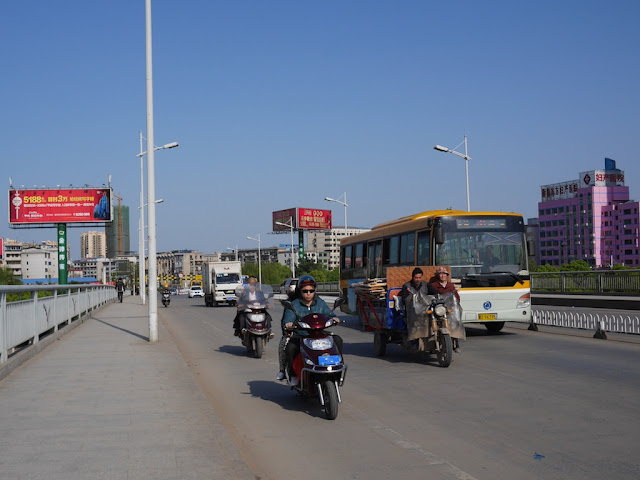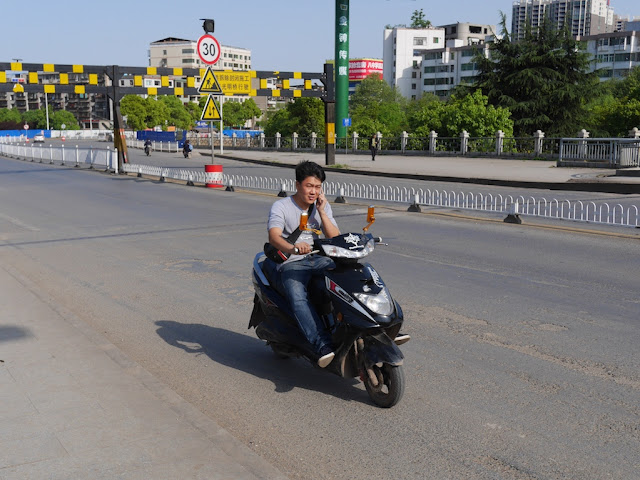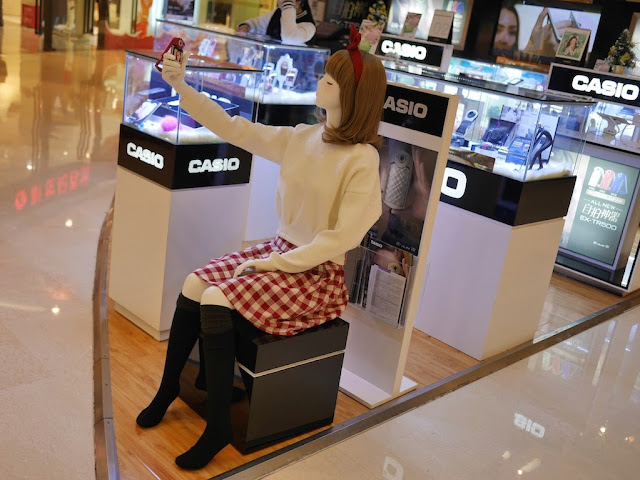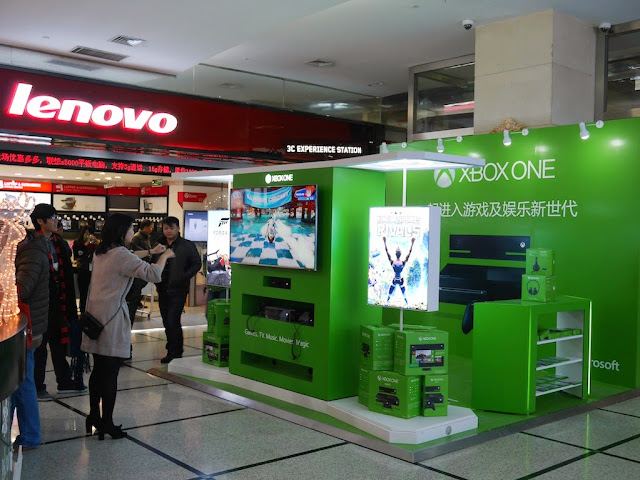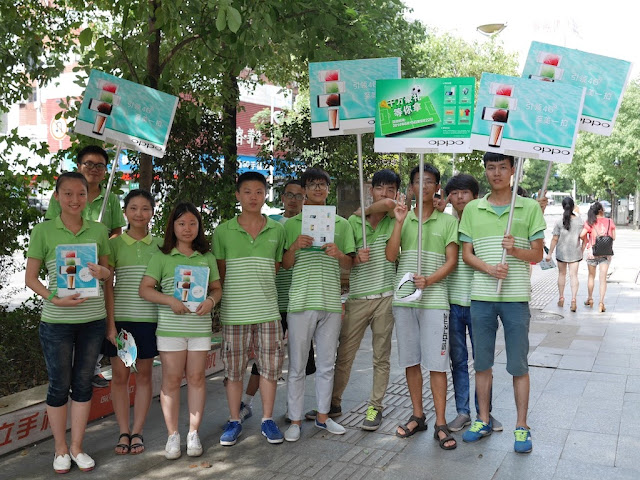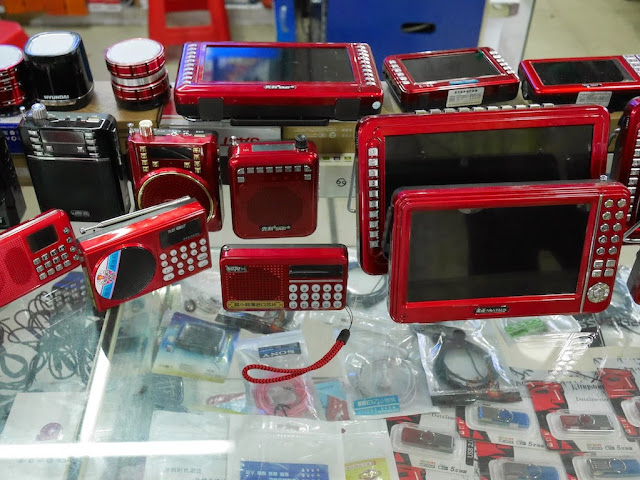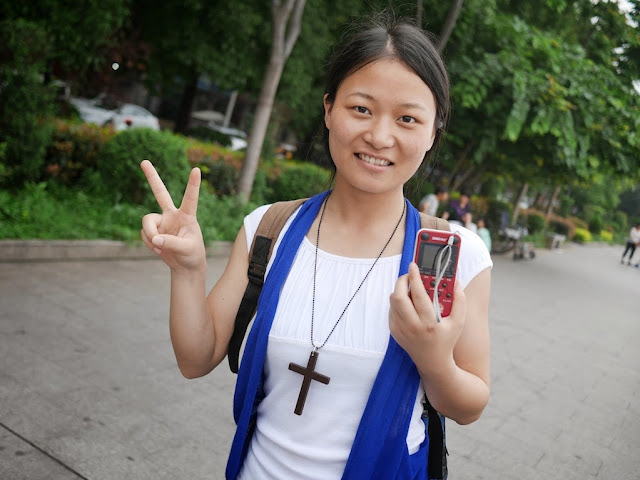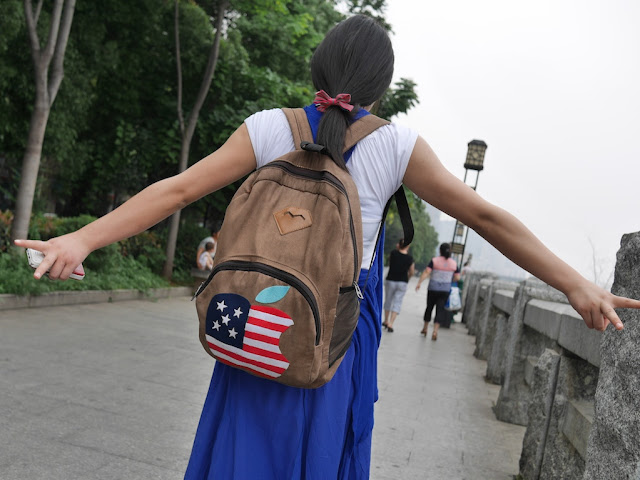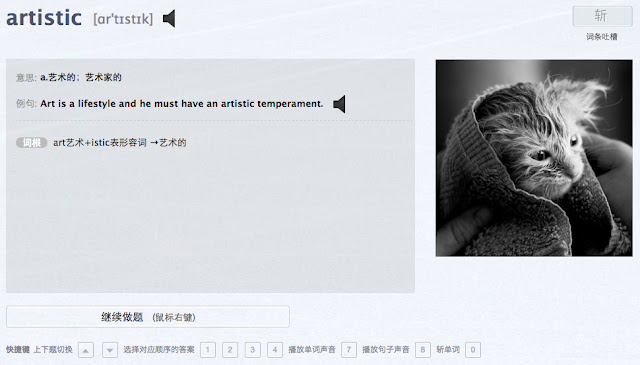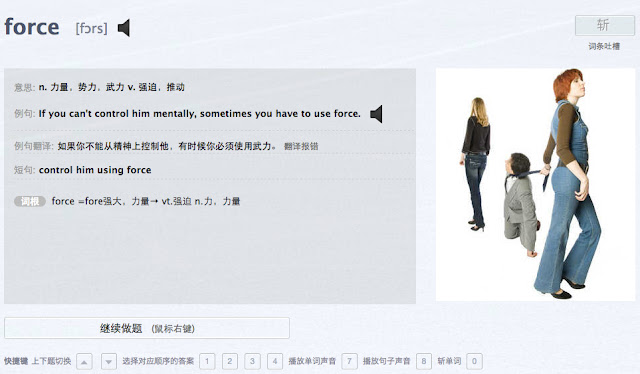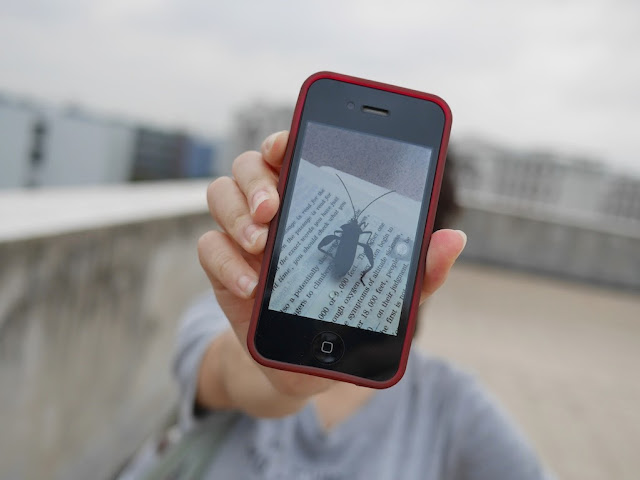A few months ago I took the above photo of a billboard from a bridge in Xiangtan, Hunan province. The advertisement for a mobile phone store featured five brands: Apple, Vivo, Xiaomi, Samsung, and Huawei. One of those in particular, Vivo, receives relatively little attention outside of China, yet, as the sign suggests, it is rather visible in some parts of China. More on that topic, tech in general, and other themes soon.
Showing posts with label Mobile. Show all posts
Showing posts with label Mobile. Show all posts
Tuesday, August 11, 2015
Sign of Things to Come: An Advertisement for Mobile Phones in Xiangtan
Posted by
Brian Glucroft
at
11:59 PM
A few months ago I took the above photo of a billboard from a bridge in Xiangtan, Hunan province. The advertisement for a mobile phone store featured five brands: Apple, Vivo, Xiaomi, Samsung, and Huawei. One of those in particular, Vivo, receives relatively little attention outside of China, yet, as the sign suggests, it is rather visible in some parts of China. More on that topic, tech in general, and other themes soon.
Wednesday, June 3, 2015
Another Sculpture in Changsha Conducive to Sitting and Photography
Posted by
Brian Glucroft
at
6:45 PM
The previous post about sculptures of string players and string instruments in Changsha mentioned that some people enjoyed having their photo taken while posing with the smaller sculptures — a common sight in numerous Chinese cities. However, the man in the post's last photo was not posing for a photographic moment but instead was taking advantage of a place to sit afforded by the sculpture. I have recently seen similar examples there and elsewhere nearby, including at the South Huangxing Road Commercial Pedestrian Street where on one occasion I saw a woman using her mobile phone while sitting on a sculpture's small stool.

Another time at the same location, I saw photography practiced in parallel with the more mundane act of sitting.
This raises an issue relevant to the design of public spaces in China: the competing interests between those who wish to use a suitable sculpture for an extended period of time as a place to sit with others who desire to use it more fleetingly for photos. Perhaps if a sufficient number of places to sit existed in the surrounding area, which research for this pedestrian street found to be a common desire, the conflict would arise less often.

Another time at the same location, I saw photography practiced in parallel with the more mundane act of sitting.
This raises an issue relevant to the design of public spaces in China: the competing interests between those who wish to use a suitable sculpture for an extended period of time as a place to sit with others who desire to use it more fleetingly for photos. Perhaps if a sufficient number of places to sit existed in the surrounding area, which research for this pedestrian street found to be a common desire, the conflict would arise less often.
Monday, June 1, 2015
A Duet and Quartet at a Mobile Phone Promotion in Changsha
Posted by
Brian Glucroft
at
11:59 PM
In the spirit of the recent themes of music and duets, last night around 8 p.m. I heard a performance with electric string instruments.
The performance was part of a promotion at a Changsha mobile phone store selling brands such as Vivo, Samsung, Apple, Gionee, HTC, and Oppo. Some of the those brands aren't familiar in many places outside of China or don't receive much international media attention. But they are common in many cities I have recently visited in Hunan and elsewhere in China. Inside the store another brand familiar in China was featured — Huawei. A quartet sans musical instruments was there to help.
A table of hors d'oeuvres and wine was also nearby. As I was full from a recent meal of spicy fish and snails, I did not partake.
Except for the hors d'oeuvres, none of this seemed exceptional for a mobile phone promotion in Changsha. Other examples to come later . . .
The performance was part of a promotion at a Changsha mobile phone store selling brands such as Vivo, Samsung, Apple, Gionee, HTC, and Oppo. Some of the those brands aren't familiar in many places outside of China or don't receive much international media attention. But they are common in many cities I have recently visited in Hunan and elsewhere in China. Inside the store another brand familiar in China was featured — Huawei. A quartet sans musical instruments was there to help.
A table of hors d'oeuvres and wine was also nearby. As I was full from a recent meal of spicy fish and snails, I did not partake.
Except for the hors d'oeuvres, none of this seemed exceptional for a mobile phone promotion in Changsha. Other examples to come later . . .
Tuesday, May 19, 2015
A One-Wheeled Phone Conversation
Posted by
Brian Glucroft
at
11:23 PM
Recently I shared examples of people using mobile phones while in control of moving motorbikes in Hengyang. Today in Changsha, I saw an example of someone using a mobile phone while riding another type of powered vehicle.
Despite the vehicle only having one wheel, I suspect the phone use presents less of a safety issue given the vehicle's slower speed and it not requiring any hands to operate. Although they are not an everyday sight, I have noticed more and more electric unicycles in use, often rented for a fun ride. I didn't ask the girl if she owned the unicycle. She appeared preoccupied as she zoomed past.
Despite the vehicle only having one wheel, I suspect the phone use presents less of a safety issue given the vehicle's slower speed and it not requiring any hands to operate. Although they are not an everyday sight, I have noticed more and more electric unicycles in use, often rented for a fun ride. I didn't ask the girl if she owned the unicycle. She appeared preoccupied as she zoomed past.
Tuesday, May 5, 2015
Motorbike Phone Calls in Hengyang
Posted by
Brian Glucroft
at
11:47 PM
The Hengxiang Bridge offers an excellent opportunity to appreciate Hengyang's "traffic culture" and the variety of vehicles used there.
It also offers an excellent opportunity to observe some real-life mobile phone usage in Hengyang. On that note, here are four photos I took as I crossed the bridge one afternoon:
In all four cases, a person was using their mobile phone while driving a motorbike. The above capture most, but not all, of the examples I saw.
Later as I walked back across the bridge, I saw one man park his bike in the dedicated bike lane and then have a phone conversation as he stood on the sidewalk.
And finally, tying it all together in what felt like a brief magical moment, I saw a man using a mobile phone while he rode by and looked at a woman who had stopped to use a mobile phone.
It is a just a small period of time and only a single location. But if representative, it suggests a large number of people in Hengyang are willing to use their phones while driving a motorbike, at least under some conditions. And much else could be learned, better appreciated, or questioned at this single bridge in Hengyang.
It also offers an excellent opportunity to observe some real-life mobile phone usage in Hengyang. On that note, here are four photos I took as I crossed the bridge one afternoon:
In all four cases, a person was using their mobile phone while driving a motorbike. The above capture most, but not all, of the examples I saw.
Later as I walked back across the bridge, I saw one man park his bike in the dedicated bike lane and then have a phone conversation as he stood on the sidewalk.
And finally, tying it all together in what felt like a brief magical moment, I saw a man using a mobile phone while he rode by and looked at a woman who had stopped to use a mobile phone.
It is a just a small period of time and only a single location. But if representative, it suggests a large number of people in Hengyang are willing to use their phones while driving a motorbike, at least under some conditions. And much else could be learned, better appreciated, or questioned at this single bridge in Hengyang.
Tuesday, April 14, 2015
Genuine, Fake, and In-between: A Visit to Electronics Markets at Shenzhen's Huaqiangbei
Posted by
Brian Glucroft
at
11:08 PM
Several days ago I spent part of one afternoon in Shenzhen's Huaqiangbei (also known as Huaqiang North) commercial area. According to ShenzhenShopper:
Theres over 20 shopping malls located in the Huaqiangbei area which provides about 70 million square meters of business area. Annual sales reaching over 20 billion, and there’s something like 130,000 people employed in the area. Yep, it’s large.Huaqiangbei is most known for being one of the biggest electronics markets in the world. For many first time visitors, especially those already familiar with typical consumer electronics chain stores in China, I would agree with the suggestion on PIXEL to:
Skip [the consumer electronics shops] and spend your time in the buildings dedicated to Android tablets, “Shanzhai” phones (copies), phone accessories, components, LEDs, various gadgets, etc.Just one of the shopping centers on its own can be overwhelming to those not accustomed with their scale, density, and intensity. Charles Arthur shared a gallery of photos on The Guardian. As prelude to another gallery of photos on Tech in Asia, Paul Bischoff wrote:
Within lies stall after stall after stall of nearly every gadget, component, and tool imaginable. Over half a dozen city blocks are filled to the brim with crowded marketplaces, each ranging from four to 10 floors high. Photos hardly do it justice. The place is immense.For a variety of reasons, I kept my photo-taking activities to a minimum this time. The photo above is of an alley on the outskirts of Huaqiangbei. On both sides are huge electronics markets which aren't labeled even on Seeed Studio's detailed Shenzhen Map for Makers (free PDF download). The several markets I visited on this block mostly focused on mobile phone products — from components to complete phones to accessories. Here is just a small taste of what I saw in these markets where the line between genuine and fake can be blurry:
- Thousands of mobile phones with cracked screens, some showing clear signs they were from the U.S.
- Screens for various brand name phones for sale.
- Workers fixing and cleaning phones.
- Workers affixing brand name labels to unmarked batteries.
- Workers packaging iPhones to appear as new.
- Foreigners making purchases, reminding me of what I learned at a fake stuffed toy wholesale store in Guangzhou.
Tuesday, March 31, 2015
Yahoo Leaves, Apple's Watch Copied, and GitHub Attacked: Assorted China Tech Links
Posted by
Brian Glucroft
at
11:56 PM
In addition to other topics, I plan a return to some China tech-related themes here. For a starter, I'll share assorted excerpts of four recent pieces sans commentary by me. Much more can be found by clicking the related links.
1. Yahoo closing its office in China received a lot of media attention. Michael Smith, an ex-Yahoo employee, provided some useful perspective:
1. Yahoo closing its office in China received a lot of media attention. Michael Smith, an ex-Yahoo employee, provided some useful perspective:
China was really just one of the last remote engineering orgs to go. Brazil gone. Indonesia gone. The centralization plan was back on target. Build in HQ – launch everywhere. Like a lot of big internet companies really.2. Even before Apple's new smart watch was publicly available, you could buy an imitation of it in China. Peter Ford reported one person's account of the processes used in China's electronics copying business:
So yes – they closed China. I don’t think it has any connection to a pull back in China since Yahoo is already gone from China. Now the engineers are too.
Big deal. Not.
If there are product details he is unsure of, he says, “I wait for the product to come out, or ideally see if I can get it earlier than the release date.” Since so many electronic goods are made in China, where factories “are leaky, very leaky,” he adds, “people will straight up offer that stuff to you.”3. Github, an online site used by many developers worldwide for coding, has been the target of a remarkable attack. Eva Dou explains the attack and why it appears that not only is the source based in China but the Chinese government is behind it:
Nor does a manufacturer of what the source calls “facsimiles” need to resort only to the black market to see engineering ahead of time. “Companies like Apple buy things from other providers and put them together in a pretty package,” he says. “I don’t even need to ‘pirate’ their stuff; I just buy it from the same guys who sell it to them [ie Apple].”
Mikko Hyponen, the chief research officer of cybersecurity firm F-Secure, said the attack was likely to have involved Chinese authorities because the hackers were able to manipulate Web traffic at a high level of China’s Internet infrastructure. It appeared to be a new type for China, he added. “It had to be someone who had the ability to tamper with all the Internet traffic coming into China.” he said.4. Erik Hjelmvik at NETRESEC provides an intriguing and in-depth look at how the GitHug attack works:
We have looked closer at this attack, and can conclude that China is using their active and passive network infrastructure in order to perform a man-on-the-side attack against GitHub. See our "TTL analysis" at the end of this blog post to see how we know this is a Man-on-the-side attack.That's all for now, folks.
In short, this is how this Man-on-the-Side attack is carried out:
- An innocent user is browsing the internet from outside China.
- One website the user visits loads a javascript from a server in China, for example the Badiu Analytics script that often is used by web admins to track visitor statistics (much like Google Analytics).
- The web browser's request for the Baidu javascript is detected by the Chinese passive infrastructure as it enters China.
- A fake response is sent out from within China instead of the actual Baidu Analytics script. This fake response is a malicious javascript that tells the user's browser to continuously reload two specific pages on GitHub.com.
Tuesday, February 10, 2015
Mannequin Takes a Selfie in Chongqing
Posted by
Brian Glucroft
at
11:59 PM
Last year I shared photos of mannequins along a street in Yangjiang. Yesterday, in front of displays for Casio products at the Times Paradise Walk shopping mall in Chongqing, another mannequin caught my attention.
A sign of the times . . .
A sign of the times . . .
Saturday, January 31, 2015
A Photographic Moment: One More Chongqing Trio
Posted by
Brian Glucroft
at
2:02 PM
After I saw the "Two Chongqing Trios" in Chongqing's Dadukou district, I saw another trio, this one including young girls. I didn't include the moment because it wasn't as near in terms of time and location as the other two trios and is something I see far more often. It did occur on the same pedestrian street though. Here it is:
Later, I will share a more complete photo of the object of photographic interest behind the two posing girls and say more about it.
Later, I will share a more complete photo of the object of photographic interest behind the two posing girls and say more about it.
Sunday, December 14, 2014
A Genuine Microsoft Store in Shanghai
Posted by
Brian Glucroft
at
11:21 PM
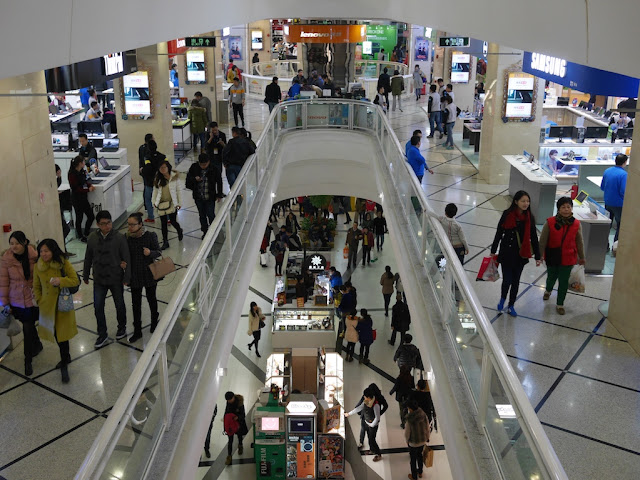 |
| 1st floor of Buynow and lower level of Metro City |
Recently at the Buynow (百脑汇) electronics shopping center in Shanghai's Metro City mall, I saw a Microsoft store set in two separate locations. I didn't see any reason to assume it was a "fake", and Microsoft's store finder identifies this shopping center as holding one of the 18 stores it currently lists in China. Much of the store space and a nearby promotion focused on the Xbox. There were tables with Surface tablets and Windows Phones as well. Notably, other than the Xbox games, I didn't see any software for sale.
I will refrain from commenting further*. After sharing so much in the past about the many unauthorized Apple stores in China and the Android store in Zhuhai, I just figured I would take advantage of this opportunity to throw in a few Microsoft store scenes for some balance and a small taste of what Microsoft is now doing in China.
*Disclosure: I previously worked as a user experience researcher for Microsoft China.
Friday, August 15, 2014
Assorted Technology in China Links: Illogical Business, Xiaomi's Growth, Fake Deals, and Your Apple in China
Posted by
Brian Glucroft
at
9:32 PM
Several recent articles about technology in China have caught my eye. Some I hope to comment on next week, but I suspect I wont make it to others. So for four of those, here are links, excerpts, and very brief comments.
1. In an interview Lenovo's Chief Executive Yang Yuanqing commented on their competitors in China's mobile phone market:
2. Market analyst Canalys says that at least in one measure Xiaomi has passed Samsung in China:
3. The profitable e-commerce company Alibaba has made a deal with some luxury brands such as Burberry:
4. In perhaps another sign of pragmatic decisions, Apple is changing how it stores users' data:
And that is all for now.
1. In an interview Lenovo's Chief Executive Yang Yuanqing commented on their competitors in China's mobile phone market:
I would say China is the most competitive market in the world. There are so many local players, and some of them are not logical in how they do business. They don’t want to make money in the short term. We definitely don’t want to lose our leadership position in China, and we must balance growth in market share with profitability.It would be interesting to hear more of Yang's thoughts about the "not logical" local players and their long term potential.
2. Market analyst Canalys says that at least in one measure Xiaomi has passed Samsung in China:
In little over a year, Xiaomi has risen from being a niche player to become the leading smart phone vendor in the world’s largest market, overtaking Samsung in volume terms in Q2. Xiaomi took a 14% share in China, on the back of 240% year-on-year growth. With Lenovo, Yulong, Huawei, BBK, ZTE, OPPO and K-Touch, the eight Chinese vendors in the top 10 together accounted for a total of 70.7 million units and a 65% market share.Though as someone from Lenovo might point out, higher volume doesn't necessarily mean higher profits.
3. The profitable e-commerce company Alibaba has made a deal with some luxury brands such as Burberry:
Like many premium brands, Burberry PLC had been fretting about a flood of discount Burberry products—some of them fakes—on Alibaba's two big marketplaces, which accounted for 80% of China's estimated $300 billion in online shopping last year. Burberry hadn't authorized any of those vendors to sell its goods.Some would say this is the pragmatic side of doing business in China.
Alibaba would do its best to get those products off its sites if Burberry opened its own shop on Alibaba's online mall, Burberry was told, according to people familiar with the talks. Burberry opened a store on Alibaba's Tmall in April.
4. In perhaps another sign of pragmatic decisions, Apple is changing how it stores users' data:
Apple Inc (AAPL.O) has begun keeping the personal data of some Chinese users on servers in mainland China, marking the first time the tech giant is storing user data on Chinese soil . . .The article notes a few issues this change raises, such as data access speeds and privacy. Relevant to these issues is a definition of "some Chinese users" that would indicate exactly who fits into this category. I haven't seen one yet.
The data will be kept on servers provided by China Telecom Corp Ltd (0728.HK), the country's third-largest wireless carrier, Apple said in a statement on Friday.
And that is all for now.
Tuesday, July 8, 2014
A Giraffe on a Vivo in Hengyang
Posted by
Brian Glucroft
at
11:57 PM
At a restaurant in Hengyang, I noticed a waitress's mobile phone.

Instead of a Starbucks cup or an insect, it featured the image of a giraffe. And the phone was one of many examples I have seen suggesting that Vivo's presence in Hengyang is far more than just promotional marches.

Instead of a Starbucks cup or an insect, it featured the image of a giraffe. And the phone was one of many examples I have seen suggesting that Vivo's presence in Hengyang is far more than just promotional marches.
Thursday, July 3, 2014
Marching for Vivo and Oppo in Hunan
Posted by
Brian Glucroft
at
11:46 PM
Two days ago in Hong Kong, thousands joined a pro-democracy march. On the same day I saw a group of people in Hengyang, Hunan province, also marching down the street.
I feel safe saying democracy was not at all on the their minds, though. Instead, the march was part of a promotion for Vivo mobile phones.
A few minutes later, I saw another group of people who were taking a break from their own march.
Again, it had nothing to do with democracy. Again, it was a promotion for a mobile phone brand—this time Oppo.
Vivo and Oppo are two Chinese brands of mobile phones often not mentioned in discussions of China's mobile phone market. Yet as the above scenes suggest, in some parts of China their presence can be easy to see.
I feel safe saying democracy was not at all on the their minds, though. Instead, the march was part of a promotion for Vivo mobile phones.
A few minutes later, I saw another group of people who were taking a break from their own march.
Again, it had nothing to do with democracy. Again, it was a promotion for a mobile phone brand—this time Oppo.
Vivo and Oppo are two Chinese brands of mobile phones often not mentioned in discussions of China's mobile phone market. Yet as the above scenes suggest, in some parts of China their presence can be easy to see.
Monday, June 16, 2014
A Variety of Mobile Devices for Sale in Hengyang
Posted by
Brian Glucroft
at
11:14 PM
Laptops, smartphones, and electronic Chinese-English dictionaries aren't the only mobile devices I have seen in Hengyang, China. At a large indoor shopping center near the Hengyang Railway Station, I saw several stores selling a variety of mobile audio and video devices.
There were radio, TV, and DVD players. The ones I checked all had USB sockets. With a USB flash drive, also for sale at the stores, the radios could play recorded music and the TVs could play recorded movies. And with the addition of a small card, watching CCTV on the TVs was no problem as well.
Elsewhere in the shopping center, I saw some of the technology in use. For example, one person was relaxing next to their shop while watching a movie on a portable DVD player.
These devices are an example of the diversity of electronics for sale in China, much of which rarely receive attention in comparison to smartphones. Yet knowing who buys these devices and why they buy them can be valuable to better designing devices with a broader range of functionality.
There were radio, TV, and DVD players. The ones I checked all had USB sockets. With a USB flash drive, also for sale at the stores, the radios could play recorded music and the TVs could play recorded movies. And with the addition of a small card, watching CCTV on the TVs was no problem as well.
Elsewhere in the shopping center, I saw some of the technology in use. For example, one person was relaxing next to their shop while watching a movie on a portable DVD player.
These devices are an example of the diversity of electronics for sale in China, much of which rarely receive attention in comparison to smartphones. Yet knowing who buys these devices and why they buy them can be valuable to better designing devices with a broader range of functionality.
Friday, June 13, 2014
A Chinese English-Learning Device, a Cross, and an American Apple
Posted by
Brian Glucroft
at
10:45 PM
The student with the Baicizhan English-learning app on her smartphone isn't the only person I have met in Hengyang who uses mobile technology to improve their language skills.
Several weeks later, an English teaching assistant visiting Hengyang from Xiangtan, Hunan, approached me while I was walking outside. She said she was excited to talk with a native English speaker.
Like the student, she carried a mobile device that helped her improve her English. Unlike the student, her device functioned solely as a Chinese-English dictionary. She said she always carried it around as was recommended in an English class she had taken. Compared with an app like Baicizhan, it raises questions about why one might purchase / use a dedicated device versus an app on a smartphone.
Finally, she wore a cross not for religious reasons but because she felt it was a fashionable accessory to her clothes. In fact, they were presented together in the store where she bought them--a not unusual sight in Chinese cities like Hengyang. And similar to my meeting with the university student, I noticed a bit of American spirit.
More on both the mobile and American spirit themes later.
Several weeks later, an English teaching assistant visiting Hengyang from Xiangtan, Hunan, approached me while I was walking outside. She said she was excited to talk with a native English speaker.
Like the student, she carried a mobile device that helped her improve her English. Unlike the student, her device functioned solely as a Chinese-English dictionary. She said she always carried it around as was recommended in an English class she had taken. Compared with an app like Baicizhan, it raises questions about why one might purchase / use a dedicated device versus an app on a smartphone.
Finally, she wore a cross not for religious reasons but because she felt it was a fashionable accessory to her clothes. In fact, they were presented together in the store where she bought them--a not unusual sight in Chinese cities like Hengyang. And similar to my meeting with the university student, I noticed a bit of American spirit.
More on both the mobile and American spirit themes later.
Thursday, June 12, 2014
A Chinese English-Learning App with Artistic Cats, Buttocks, and American Spirit
Posted by
Brian Glucroft
at
11:38 PM
One day as I was walking by the above sports field at the University of South China in Hengyang, Hunan, I heard a student practicing English. While wearing earphones and looking at the screen of her Xiaomi mobile phone, she would say a word and after a brief pause say a sentence which included the word.
As part of her preparations for an important English test, she was using an English-learning app a friend of hers had recommended months ago. The Chinese name for the app is "百词斩". I am not aware of an English name, so I will use its romanized spelling in pinyin: "Baicizhan". Browser-based and paper-based versions are available at the Baicizhan website. It is also available on both iTunes and Google Play. Although Baicizhan provides a link to iTunes, for the Android version Baicizhan now offers a direct download, not surprising since Google is heavily blocked in China.
After looking at the online version, I would say it certainly has room for improvement. I am not familiar with language-learning theory, so I will refrain from conducting a full review of Baicizhan. However, I won't refrain from sharing a bit about how it works and some striking examples.
A section usually begins with multiple choice questions:
One voice says the word and another says the sentence. After choosing the photo one thinks best matches the sentence, the answer is provided along with the word's definition:
The above example is from a section Bacizhan says is using a nonstandard vocabulary list. Based on the section's name and other examples, it appears to deliberately use strange or funny examples to help people remember the words. Even so, it seems peculiar to say the photo of the kitten is a good answer for the above question.
Here are two other examples of Baicizhan's wit in the same section:
Many of the English words in the section were rather familiar to me, but I did learn (or perhaps relearned) something:
Photo 2 is the correct answer. I now know that "holothurian" is another name for a sea cucumber and that the word can be used as an adjective. I dissected a sea cucumber in a high school marine biology class and ate my first sea cucumber–they are a Chinese delicacy–in Jinan, Shandong. Some sea cucumbers are especially remarkable in their ability to "confuse or harm predators is [sic] by propelling their own toxic internal organs from their anus in the direction of attack". But I don't think that is the reason Bacizhan described the cat as holothurian. Instead, it is presumably referencing the cat's shape. I can't find a single instance of a cat being described as holothurian anywhere else. Regardless, Bacizhan delivered. I now know the word and await an opportunity to use it.
Overall, the words, questions, and images I saw in other sections, some of which include vocabulary to prepare for American or Chinese college entrance exams, were more mundane, though some still gave me pause.
And none of what I saw online captured the American spirit like what caused me to stop as I was walking by the student in Hengyang. I heard her say, "Facsimile. This is a facsimile of the original U.S. Constitution; of course it's not real." When she said the sentence, her phone wasn't displaying a Starbucks cup or an insect like I had seen on other students' mobile phones. Instead, along with the sentence and definition for "facsimile", it displayed an image of the U.S. Constitution, the U.S. flag, and a military dog tag.
It appears to be a cropped version of a stock photo by Sergey Kamshylin.
The title of the photo: "Freedom is not free".
Well, at least Baicizhan is free.
Sunday, June 1, 2014
Wi-Fi and Notes in a Hengyang Black Tide
Posted by
Brian Glucroft
at
8:24 PM
Admittedly, it was the name of a cafe on Changsheng Road in Hengyang, Hunan, which first caught my attention.
But I have returned to Black Tide (黑潮) several times due to its decent inexpensive iced milk tea and the friendly woman who has been working there anytime I have stopped by.
When there, I have seen a mostly younger crowd. Sometimes they are using a piece of modern technology, whether a laptop ...
or, more commonly, a mobile phone, useful for taking advantage of Black Tide's free Wi-Fi.
And sometimes they are writing messages on colored paper to publicly post there.
Free Wi-Fi, mobile devices, and colored notes with customers' messages can be found in many other cafes in China. This mix reminds me of issues and questions I earlier discussed regarding the value of looking at people's offline world when conducting user research for online services.
And it shows, like a reading protest in Thailand (related AP report), how paper can still matter in a high tech world.
But I have returned to Black Tide (黑潮) several times due to its decent inexpensive iced milk tea and the friendly woman who has been working there anytime I have stopped by.
When there, I have seen a mostly younger crowd. Sometimes they are using a piece of modern technology, whether a laptop ...
or, more commonly, a mobile phone, useful for taking advantage of Black Tide's free Wi-Fi.
And sometimes they are writing messages on colored paper to publicly post there.
Free Wi-Fi, mobile devices, and colored notes with customers' messages can be found in many other cafes in China. This mix reminds me of issues and questions I earlier discussed regarding the value of looking at people's offline world when conducting user research for online services.
And it shows, like a reading protest in Thailand (related AP report), how paper can still matter in a high tech world.
Monday, May 12, 2014
A Mother's Day Promotion in China with WeChat and QR Codes
Posted by
Brian Glucroft
at
11:58 PM
Unlike a Mother's Day several years ago in Zigong, Sichuan province, I didn't see any fashion shows yesterday in Hengyang, Hunan province. However, I saw some signs of Mother's Day at a few shopping centers and stores. One especially caught my eye because of its use of technology and flowers.
Outside of a shopping center with small clothing stores primarily targeting younger women, there was a Mother's Day promotion. In return for a flower and other possible gifts to give one's mother, people were asked to do two things.
One, people captured an image of a QR code through the mobile phone app for WeChat--called "Weixin" in China.
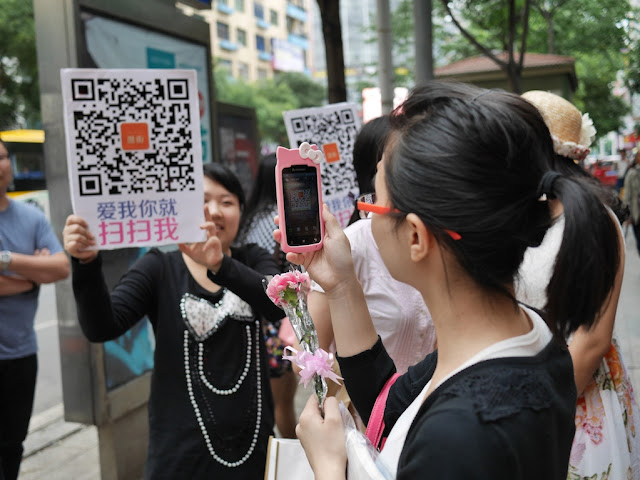
After the code was read, people found that they were now following the shopping center's WeChat account.
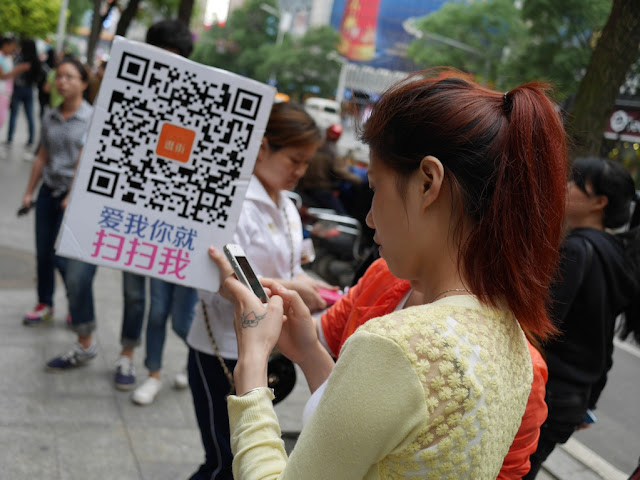
Two, people were also asked to write their name and phone number on a pad of paper.

During the time I was around, there was a constant stream of people going taking the two steps for receiving a free gift (sometimes receiving it in the middle if they signed their names first)--a possible sign of many things, including the popularity of smartphones and WeChat in China. It's definitely not the first instance of using QR codes and WeChat as part of a marketing campaign in China though. The use of a pad of paper instead something more high-tech for collecting names and numbers also raises some interesting issues.
Finally, although I didn't follow their WeChat account or provided my name and number, one of the people working for the promotion gave me a flower and a mousepad.


Since my mother is nowhere near Hengyang, I was not able to give her the gifts as intended. Instead, I passed them on to people I later met. Perhaps they made their way to other mothers.
Outside of a shopping center with small clothing stores primarily targeting younger women, there was a Mother's Day promotion. In return for a flower and other possible gifts to give one's mother, people were asked to do two things.
One, people captured an image of a QR code through the mobile phone app for WeChat--called "Weixin" in China.

After the code was read, people found that they were now following the shopping center's WeChat account.

Two, people were also asked to write their name and phone number on a pad of paper.

During the time I was around, there was a constant stream of people going taking the two steps for receiving a free gift (sometimes receiving it in the middle if they signed their names first)--a possible sign of many things, including the popularity of smartphones and WeChat in China. It's definitely not the first instance of using QR codes and WeChat as part of a marketing campaign in China though. The use of a pad of paper instead something more high-tech for collecting names and numbers also raises some interesting issues.
Finally, although I didn't follow their WeChat account or provided my name and number, one of the people working for the promotion gave me a flower and a mousepad.


Since my mother is nowhere near Hengyang, I was not able to give her the gifts as intended. Instead, I passed them on to people I later met. Perhaps they made their way to other mothers.
Monday, May 5, 2014
Brand Names Can Set Expectations Even for Known Imitators in China
Posted by
Brian Glucroft
at
11:12 PM
In an article in The New York Times about the imitation of well-known international brand names in China's hotel industry (HT Helen Gao), Julie Weed shared a viewpoint from one international hotel:
Surely this effect is not limited to only hotels and mobile phones. And it is one reason why customers' being able to distinguish genuine from imitation isn't necessarily enough for a company to avoid losing business to its imitators.
“We do take steps to protect our brand, " said Sian Griffiths, director of communications for the Hong Kong Peninsula Hotel. “However, we also feel that our target customers are sufficiently discerning not to confuse the Peninsula-branded hotels with the copycats.”But an example Weed shares shows why The Peninsula Hotels may still have reason for concern:
Li Quan, a pharmaceutical sales representative traveling on business this week in Shanghai, said he knew the Hengsheng Peninsula International Hotel was not part of the international Peninsula chain, but believed it would be an “upscale hotel because of the obvious name resemblance.”Using similar logic as Li, people may also buy mobile phones, such as the iPncne I saw in Yinchuan, even if they are recognized as imitating a well-known international brand. Several years ago in a post about how local rates, fashion, and fakes are relevant to mobile phones in China I shared a relevant example from Shuolong, Guangxi:
He was disappointed to find “so-so facilities and worse-than-average service,” and said that some domestic hotels tried “to boost their value and brand awareness by sharing names with other reputable hotel chains so they can achieve a make-believe attachment to those hotels.”
Her dream phone was a Nokia. Not because of any concerns regarding fashion but because she believed it would be very reliable and rugged. However, a real Nokia phone was not a possibility given their relatively high price so she wanted to get a fake Nokia phone since it would be cheaper.The hotel and mobile phone examples show if brand X's name is used in some way by an known imitator in China, people can have an expectation that an X-ish level of quality or type of experience will be delivered. If the imitator is then chosen, those expectations may positively color later perceptions, or they may draw attention to any shortcomings. That brand names can have such powerful carryover effects for known imitators is yet another sign of their value.
Unlike many other examples I've seen of purchasing fake products, her choice of a fake Nokia versus other relatively inexpensive options did not appear to be driven by how others around her would perceive the product. It was about her own internal expectations for what the product could provide to her based on its name - even though it would be a fake.
Surely this effect is not limited to only hotels and mobile phones. And it is one reason why customers' being able to distinguish genuine from imitation isn't necessarily enough for a company to avoid losing business to its imitators.
Monday, April 21, 2014
A Buggy Experience on a Zhanjiang Student's Mobile Phone
Posted by
Brian Glucroft
at
11:10 PM
At Guangdong Ocean University in Zhanjiang, I met a student who on her own initiative showed me a photo on her mobile phone.
The photo contrasted with a Starbucks photo I saw several days earlier about 1 hour away on a Zhanjiang Normal University student's phone.
Starbucks and a bug are two genuine experiences Zhanjiang students' captured with their mobile phones. On the surface such photos can seem very different, but what they hold in common at deeper levels can be more revealing.
The photo contrasted with a Starbucks photo I saw several days earlier about 1 hour away on a Zhanjiang Normal University student's phone.
Starbucks and a bug are two genuine experiences Zhanjiang students' captured with their mobile phones. On the surface such photos can seem very different, but what they hold in common at deeper levels can be more revealing.
Subscribe to:
Posts (Atom)






